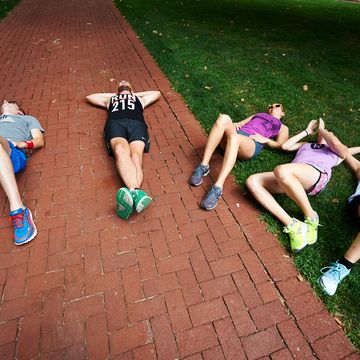There are lots of interesting theories out there about how to train better and race faster; I write about them on a regular basis. But it's important not to get so wound up in theoretical discussions that we forget to take a look at what the most successful athletes are actually doing in real life. There's been a push recently from sports scientists to get more field data from top athletes published and into the public domain, which is a great development. Along those lines, there's an interesting new study from Norwegian researchers in PLoS ONE that analyzes the training of 11 Olympic and World Championship gold medalists in XC skiing and biathlon. Specifically, they look at exactly one year of training for each athlete, culminating in that athlete's greatest triumph. In other words, it's a study of exactly what those athletes did when they got everything right.
There's a ton of interesting stuff in the paper, which is freely accessible to read -- it's worth a look if you're interested in how to plan and periodize endurance training. Some of the details are specific to skiing -- e.g. on average, the 11 athletes trained for 800 hours in 500 sessions in the year leading up to their championship race. That's a detail that can't be readily transferred to other sports with different muscular demands: as the study notes, top runners tend to train "only" ~500 to 600 hours per year. Interestingly, there was a trend over time suggesting that athletes are training harder (or at least more) than they used to. The subjects won their gold medals between 1985 and 2011; the more recent the championship year, the greater the training volume they were likely to do (but in the same number of sessions).
Another pattern: about 90% of the training time was below lactate threshold, while 10% was above. This is fairly consistent with previous studies of elite athletes, which tend to show around an 80/20 split.
The most interesting contrast between training theory and practice is in the taper. There have been lots of studies on how to taper, and several common pieces of advice emerge from those studies: taper for about two weeks; drop your volume by 40-60%; maintain training frequency and intensity; and so on. In practice, here's what the tapers looked like:
The key difference is that these athletes weren't able to focus all their attention on tapering for a single race. Instead, they had to bring down their volume by 24% (on average) six weeks before the championships in order to compete in key World Cup races. From there, in the final two weeks before the championship, they only dropped another 9%. This is the reality of competing on the circuit. Is it optimal? Who knows, but when coaches are planning training they have to take these scheduling issues into account.
There are some other interesting points that emerge when you look more closely at the taper (which you can see in Figure 7 of the original paper). For example, many athletes took a rest day between 12 and 6 days before the championship, but only 3 of the 11 athletes took a rest day in the last five days before the race. In contrast, 10 of the 11 athletes did a high-intensity interval session within 48 hours of the championship final. The picture that emerges (which, as it happens, is consistent with theoretical models of how to taper) is that you get maximally rested up a week or so before the competition, rather than right before the competition, then ramp your training back up in the final few days to make sure you're in the rhythm and not rusty.
Anyway, those are a few highlights -- as I said, if you're interested in this stuff, it's worth checking out the original paper. After all, these are the people who got it right.
***
Read Planning the Perfect Peak, and follow the latest posts via Twitter, Facebook, or RSS.










